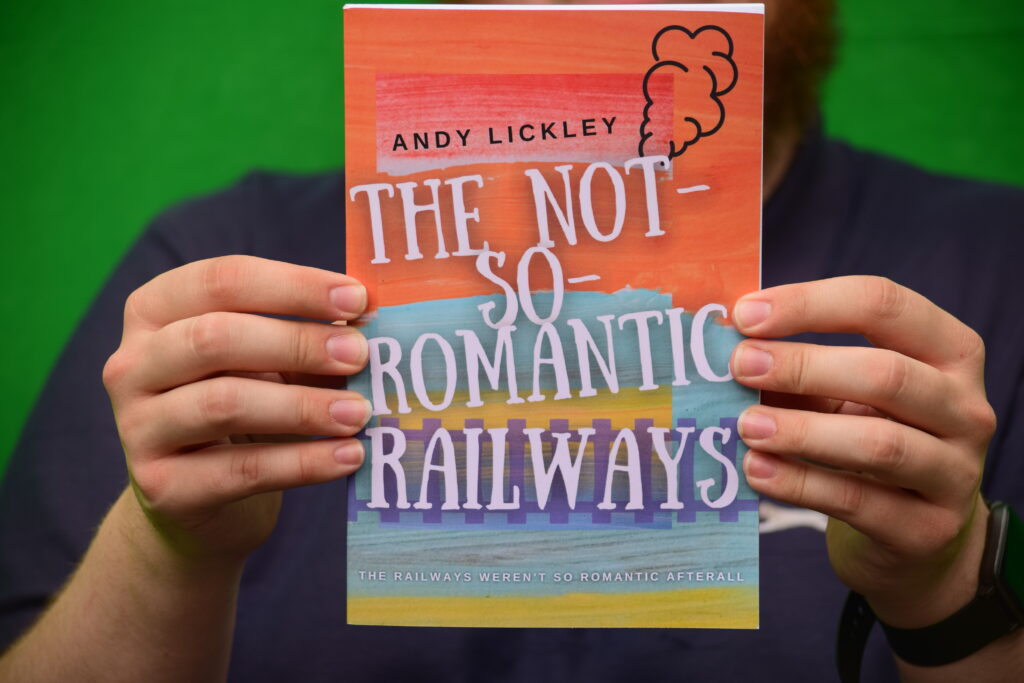Steam locomotives are mysterious things and not to brag but I know a lot about them. You can see the true extent of my knowledge in my latest book “The Not-So-Romantic Railways.”
Today I’m challenging myself to answer the 20 most searched questions about steam locomotives without looking them up! Let’s hope for the sake of my ego I can answer them all.

#1 Do we still use steam locomotives?
Not for regular services and certainly not in the UK.
I remember there were still some steam locomotives being used in China a couple of years ago so perhaps they’re still working today. Nowadays steam locomotives are used for special trips (excursions) and they’re normally really expensive- worth it, but expensive.
#2 What does the steam locomotive do?
When they were in their prime steam locomotives did a whole range of jobs- transporting passengers, freight, and pretty much everything else.
Nowadays, steam locomotives are reserved for museum objects or for pulling special trains.
#3 Who invented the steam locomotive?
Richard Trevithick built the first steam locomotive, but it’s likely he combined the ideas of lots of other people of the time. He built a locomotive for Coalbrookdale ironworks in the early 1800s. (1804?) A lot of people will try and tell you that someone called George Stephenson invented them- these people are wrong.
#4 How much is a steam locomotive worth?
To work out how much things are worth I always think a good method is to work out how much it would cost to replace them. In the case of the last remaining steam locomotive of a type (class) then you would have to say that the steam locomotive is priceless because it would be impossible to replace.
#5 How many steam locomotives are left?
I genuinely have no idea. It also depends if this question is asking how many are still running or just how many are left in museums.
I know of at least 60 (I ain’t going to name them) so I would imagine it’s between 1000-3000 left in total and maybe 300 of them are still in working order.
#6 Did Queen Victoria have a train?
Queen Victoria definitely had her own carriages built and was the first ruling monarch to travel by rail. She wouldn’t have had her own locomotive but the railway companies would use the same locomotives to pull the royal carriages.
#7 What’s the difference between a steam locomotive and a steam train?
This is a good question and one that lots of people get confused about. A steam locomotive is just the vehicle where the Driver and Fireman are. We call it a steam locomotive when there are no carriages attached.
This means that when there are carriages attached it becomes a steam train. It’s the carriages that make it a train.

#8 Could steam locomotives make a comeback?
Personally, I don’t think so. With the focus on renewable energy and protecting the Earth from global warming burning heaps and heaps of coal which will pump even more Carbon Dioxide into the atmosphere would not be a good business model.
And honestly, there’s just better technology out there now.
#9 What was the last steam locomotive built?
The last steam locomotive built for British Rail was Evening Star in 1960. The last steam locomotive built in Britain was Tornado – though you could argue it was Flying Scotsman as it was practically rebuilt with all new parts.
#10 Which is the fastest steam locomotive in the world?
Mallard. It was built in 1938 in Doncaster and reached a top speed of 126 miles per hour! It’s still the fastest steam locomotive, on record, in the world today!
#11 which is the best steam locomotive?
How do you define the best? The fastest? The most reliable? I’m not sure I can answer this question as “best” will be different for everyone.
Some of the Great Western Railway locomotives were very reliable so I would guess one of them.
#12 What comes out of a steam locomotive funnel?
Firstly- it’s a chimney. They must call it a funnel in America- but I’ve only ever heard it being called a chimney. Exhaust steam comes out of the steam locomotive chimney.
Exhaust steam is steam that has already been used to help push the wheels around.
#13 How does a steam locomotive work?
I’m going to refer you to chapter 2 of my book The not-so-romantic railways to answer this question. Otherwise, this blog will be about 50 pages long and take you a month and a half to read.
#14 Is there only one Flying Scotsman?
Yep- there’s only one Flying Scotsman. The service it used to run (London to Edinburgh) on was also called Flying Scotsman which often leads to a lot of confusion.
#15 What train is used in Harry Potter?
Not to brag but I’ve driven the Hogwarts Express, not to Hogwarts, but I’ve still driven it. The locomotive they used was originally called “Olton Hall”. It was a Great Western Railway locomotive and was originally green.
#16 What does LNER stand for?
London North Eastern Railway. Phew- that was short and sweet.
#17 Why are all locomotives black?
I wasn’t aware all steam locomotives were black. I’ve definitely seen some green, red and blue ones. Anyway, in an attempt to answer the question… During the second world war, steam locomotives were painted black so they were harder to see at night. And I suppose dirt and muck don’t show up as easy on black paint so perhaps it saved on the cleaning bill?
#18 Why did German steam locomotives have red wheels?
If I remember right I think it was to help the safety inspectors spot if there were any cracks on the wheels easier.
#19 Which is the most popular steam locomotive
I loathe to say it but the most popular steam locomotive is Flying Scotsman, closely followed by Mallard and Rocket.
#20 How long does it take to start a steam locomotive?
This depends on the size of the locomotive but it could take anything up to 8 hours to get a steam locomotive ready to go.
Got any more questions about steam locomotives? Leave them in the comments down below and who knows, maybe some of them will become a blog one day!
Click here to be taken to the not-so-romantic Amazon page

